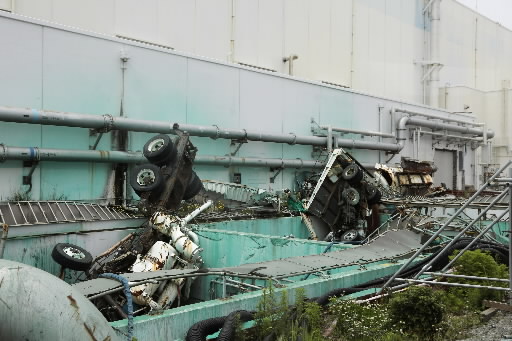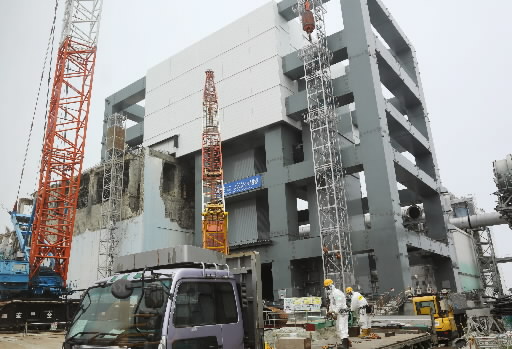Report from the crippled nuclear power plant in Fukushima
Jun. 24, 2013
by Uzaemonnaotsuka Tokai, Editorial Writer
On June 14, I entered the compound of the Fukushima No. 1 (Daiichi) nuclear power plant, operated by the Tokyo Electric Power Company (TEPCO), where work to decommission the facility is ongoing. Sitting side by side on the ground are about 1,000 tanks which hold a massive amount of contaminated water and preparations to remove spent nuclear fuel is proceeding at reactor No. 4. Where the level of radiation is particularly high, vehicles that were pushed by the tsunami and debris from the hydrogen explosion remain scattered around the site. It looks like time has stopped since the earthquake struck two years and three months ago.
As we approached reactor No. 3, which had suffered a nuclear core meltdown, the inside of our bus of reporters fell deathly silent. The TEPCO official who was accompanying us had just made a reading on his dosimeter--and the level of radiation stood at 1,800 microsieverts per hour. This level is so high that a permissible dose of radiation for an entire year can be exceeded in just 30 minutes or so.
At Reactor No. 4, where the upper part of the containment building was blown away by an explosion, the outer walls have tumbled down, exposing the framework. TEPCO said that it will begin working to remove the spent nuclear fuel in November by installing a crane on this framework.
One of the biggest challenges in the process of decommissioning a nuclear reactor is addressing contaminated water. Today TEPCO continues to pour water over reactors No. 1, No. 2, and No. 3 to keep them cool, removing most of the radioactive substances from the water to then reuse it. However, as much as 400 tons of groundwater are flowing into the reactor buildings each day, hampering the work.
It takes 30 to 40 years to decommission a nuclear reactor. And methods to safely remove melted nuclear fuel have yet to be devised.
I spent about one hour and 20 minutes on the grounds of the nuclear plant. The dosimeter I had placed in my chest pocket gave a reading of 21 microsieverts. Each day 3,000 people work under these grim conditions. The horror of invisible radiation and the overwhelming dilemma of decommissioning a nuclear reactor was driven home to me more deeply than ever.
When the 150,000 evacuees who once resided in this region can return to their homes is unknown. Such circumstances make it impossible to say that life here has returned to anything approaching normalcy.
(Originally published on June 15, 2013)
On June 14, I entered the compound of the Fukushima No. 1 (Daiichi) nuclear power plant, operated by the Tokyo Electric Power Company (TEPCO), where work to decommission the facility is ongoing. Sitting side by side on the ground are about 1,000 tanks which hold a massive amount of contaminated water and preparations to remove spent nuclear fuel is proceeding at reactor No. 4. Where the level of radiation is particularly high, vehicles that were pushed by the tsunami and debris from the hydrogen explosion remain scattered around the site. It looks like time has stopped since the earthquake struck two years and three months ago.
As we approached reactor No. 3, which had suffered a nuclear core meltdown, the inside of our bus of reporters fell deathly silent. The TEPCO official who was accompanying us had just made a reading on his dosimeter--and the level of radiation stood at 1,800 microsieverts per hour. This level is so high that a permissible dose of radiation for an entire year can be exceeded in just 30 minutes or so.
At Reactor No. 4, where the upper part of the containment building was blown away by an explosion, the outer walls have tumbled down, exposing the framework. TEPCO said that it will begin working to remove the spent nuclear fuel in November by installing a crane on this framework.
One of the biggest challenges in the process of decommissioning a nuclear reactor is addressing contaminated water. Today TEPCO continues to pour water over reactors No. 1, No. 2, and No. 3 to keep them cool, removing most of the radioactive substances from the water to then reuse it. However, as much as 400 tons of groundwater are flowing into the reactor buildings each day, hampering the work.
It takes 30 to 40 years to decommission a nuclear reactor. And methods to safely remove melted nuclear fuel have yet to be devised.
I spent about one hour and 20 minutes on the grounds of the nuclear plant. The dosimeter I had placed in my chest pocket gave a reading of 21 microsieverts. Each day 3,000 people work under these grim conditions. The horror of invisible radiation and the overwhelming dilemma of decommissioning a nuclear reactor was driven home to me more deeply than ever.
When the 150,000 evacuees who once resided in this region can return to their homes is unknown. Such circumstances make it impossible to say that life here has returned to anything approaching normalcy.
(Originally published on June 15, 2013)








